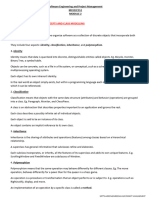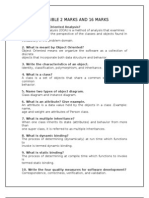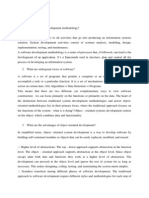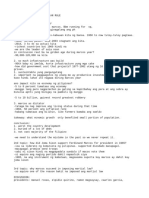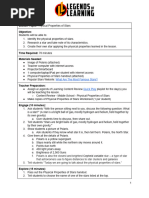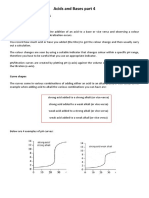Software Testing Is An Investigation Conducted To Provide Stakeholders With Information About The
Software Testing Is An Investigation Conducted To Provide Stakeholders With Information About The
Uploaded by
Jilani ShaikCopyright:
Available Formats
Software Testing Is An Investigation Conducted To Provide Stakeholders With Information About The
Software Testing Is An Investigation Conducted To Provide Stakeholders With Information About The
Uploaded by
Jilani ShaikOriginal Title
Copyright
Available Formats
Share this document
Did you find this document useful?
Is this content inappropriate?
Copyright:
Available Formats
Software Testing Is An Investigation Conducted To Provide Stakeholders With Information About The
Software Testing Is An Investigation Conducted To Provide Stakeholders With Information About The
Uploaded by
Jilani ShaikCopyright:
Available Formats
EXPECTED SHORT ANSWER QUESTIONS PREPARED BY Mr.JILANI BASHA,MTECH (C.S.E) 1.Define modelling?
A model is an abstract representation of a system, constructed to understand the system prior to building or modifying it. It is a model of a simplified representation of reality. Models can represent static or dynamic situations. 2. Define Software Testing? Software testing is an investigation conducted to provide stakeholders with information about the quality of the product or service under test.[1] Software testing can also provide an objective, independent view of the software to allow the business to appreciate and understand the risks of software implementation. Test techniques include, but are not limited to, the process of executing a program or application with the intent of finding software bugs (errors or other defects) 3. Define reuse? In some organizations,reuse may just about making use of reusable components from elsewhere ,using the kinds of mechanisms .In others, reuse will be about the kind of organizational change.
4. Define hard methodology? A hard approach will be more appropriate once any initial uncertainties and ambiguities have been resolved,since the emphasis then shifts to a specific project with relatively clear goals and boundaries.
5. Define template? Patterns may be documented using one of several alternative templetes.The pattern template determines the style and structure of the pattern description,and these vary in the emphasis they place on different aspects of patterns.
6. Define pattern? A pattern is an instructive information that captures the essential structure and insight of a successful family of proven solutions to a returning problem that arises within a certain context and system of forces .
7. Define view? View can be defiened as ,the classes that provides the display to the user.Each view corresponds to a particular style and format of presentation of information to the user.The view rettrives data from the model and updates its presentations when data has been changed in one of the other views.
8. Define persistent object? A file or database can provide support for objects having a longer lifeline,longer than the duration of the process for which they were created. This is called object persistence. An object can persist beyond application session boundaries, during which the object is stored in a file or database. The object can retrieved in an other application session and will have same state and relationship. 9. Define sequential sub states? In the basic form of sequential sub states,each sub state is written or placed in some predetermined order. 10. Define consistency checking? Consistency cheks are an important task in the preparation of complete set of models.This process highlights omissions and errors,and encourages the clarification of any ambiguity or incompleteness in the requirements. 11. Define actor? An actor is an external entity of any form that interacts with the system.Actors may be physical devices,humans or information systems. 12.Define guard condition? A guard is a logical condition tht will return only true or false. A guarded trasition only if the guard resoled to true.
13.defne model consistency? The preparation of interaction diagrams involves the allocation of operations to classes.These operations should be listed against the correct classes in the class diagram and if operation signature s have been specified in full these must be consistent. 14.define synchronous action? In telecommunication signaling within a network or between networks, synchronous signals are those that occur at the same clock rate when all clocks are based on a single reference clock 15.what is use case view? The usecases are the major elements that describes the behaviour of the system.The end users,analysts and testers are the specimen who are majorly concerned with the use case view.
16.define normalization? A technique that groups attributes based upon functional dependencies according to several rules to produce normalized data structures that are largely redundancy free.
17.define unit testing? Tests focus on each component individually,ensuring that it functions properly as a unit.Hence,the name Unit testing.It makes heavy use of testing techniques that exercise specific paths in a components control structure to ensure complete coverage and maximum error detection.
18.Define deployment Case view? Deployment diagrams indicate the processing elements,processes,software components.The static deployment view of a system in terms of different components,processes can be modelled by deployment diagrams. 19.Define transition? The movement from one state or activity to another , trigged by an event. A transition may start and end at the same state. 20.define persistent object? A file or database can provide support for objects having a longer lifeline,longer than the duration of the process for which they were created. This is called object persistence. An object can persist beyond application session boundaries, during which the object is stored in a file or database. The object can retrieved in an other application session and will have same state and relationship. 21.Define modelling? A model is an abstract representation of a system, constructed to understand the system prior to building or modifying it. It is a model of a simplified representation of reality. Models can represent static or dynamic situations
22.what is an object and model? The term object means a combination of data and logic that represents some real world entity. Ex:- Object car Data:Color,Price Logic:Stop,go move left. A model is an abstract representation of a system, constructed to understand the system prior to building or modifying it. It is a model of a simplified representation of reality. Models can represent static or dynamic situations. 23.what is a use case? Use case is a special flow of events. Many courses of events are possible and they are similar to one another . So we group the courses of events called use case class.
24.what is data modelling? In order to store the objects from an object-oriented system in a relational database,the objects must be flattend out. 25.what is multiplicity? A constraint that specifies the range of permitted cardinalities(q.v.) for example in an association role or in composite class . An association may have a multiplicity of 1..5; a particular instance of that association may have cardinality of 3.
26. When would you use interaction diagrams? Why because the message passing between objects within the content of collaboration to achieve a particular behaviour. 27.what is the 80-20 rule? 80-20 rule applies for documentation. 80% of work is done with 20% of documentation. 20% is easily accessible but remaining 80% is available to only those who need to know. 28.what are the event classes? Event classes are classified into 4 types, 1.signaling 2.Calls 3.Time event 4.Change of state evnt. 29.what are the people classes?
People class refers to a group of people with similar levels of wealth, influence, and status. Sociologists typically use three methods to determine people class:
The objective method measures and analyzes hard facts. The subjective method asks people what they think of themselves. The reputational method asks what people think of others.
30.what is association? A logical connection,usually between different classes although in some circumstances a class can have an association with it self.An association describes possible links between objects,and May correspondent either to logical relationships in the application domain or to message paths in software.
31.what is generalization? The abstraction of common features among elements by the creation of a hierarchy of more general elements that encapsulates the common features.
32.what is task of design?
Activities are the main building blocks of Android applications. In addition to writing your own activities, you are free to re-use activities from many other applications through intents. You can enable activities in your application to be started from intents in other applications. In nearly all cases, the activity stack just works as expected. In a couple of cases you might need to ensure the right thing happens by setting a string or flag.
33.what is KISS? Software design is not a haphazard process.All design should be As simple as possible,but no simpler.This facilitates having a more easily understood,and easily maintained system. 34.why do users find OOUI easier to use?
In computing an object-oriented user interface (OOUI) is a type of user interface based on an object-oriented programming metaphor. In an OOUI, the user interacts explicitly with objects that represent entities in the domain that the application is concerned with. Many vector drawing applications, for example, have an OOUI - the objects being lines, circles and canvases. The user may explicitly select an object, alter its properties (such as size or colour), or invoke other actions upon it (such as to move, copy, or re-align it). If a business application has any OOUI, the user may be selecting and/or invoking actions on objects representing entities in the business domain such as customers, products or orders.
35.what is model? A model is an abstract representation of a system, constructed to understand the system prior to building or modifying it. It is a model of a simplified representation of reality. Models can represent static or dynamic situations 36.define usecase?
From users prespective,a behaviourally related set of transactions that are normally performed together to produce some value for the user.usecases can be represented graphically in a usecase diagram,each use case being described in the data dictionary. another classifier guarentees to carryout that contracts.
37.define realization? It is a relationship between classifiers in which one classifier specifies the contracts that another classifier guarentees to carryout that contracts.
38.define pattern? A pattern is an instructive information that captures the essential structure and insight of a successful family of proven solutions to a returning problem that arises within a certain context and system of forces 39.what is state chart diagram used for? In the UML state chart diagrams are used to model the behavioural aspects of the system.State chart diagram comprises staes and events.
40.what is meant by the term model consistency? The preparation of interaction diagrams involves the allocation of operations to classes.These operations should be listed against the correct classes in the class diagram and if operation signature s have been specified in full these must be consistent
41.Define normalization? A technique that groups attributes based upon functional dependencies according to several rules to produce normalized data structures that are largely redundancy free. 42.write any two criteria for good design? A design will typically be considered good if it fulfills the requirements in a meaningful way. If any aspect of the design cannot be justified, then it is probably worth reevaluating. Many programmers try to incorporate design patterns into their work, and they often add unnecessary complexity. You should be able to list at least one compelling reason, related to the requirements, for why a design decision was made. That reason must then be documented. Diagrams are a great tool for visualizing your design, but they cannot convey the motivation behind your design decisions. That is why it is so important to let diagrams supplement your design document, not be your design document.
43.define concurrency? In most systems there are many objects that do not need to operate concurrently but some may need to be active simultaneously.Object-oriented modelling captures any inherent concurrency in the application principally through the development of interaction diagrams and statecharts.
44.what is generalization? The abstraction of common features among elements by the creation of a hierarchy of more general elements that encapsulates the common features.
45.describe single and multiple inheritance? It is quite possible,and often appropriate,for a class to be simultaneously the subclass of morebthan one superclass.This is not an unfamiliar concept in terms of everyday classification.
46.what is the relationship between coupling and cohesion? Coupling deals with interactions between objects or software components while cohesion deals with the interactions within a single object or software component. Highly cohesive components can lower coupling because only a minimum orf essential information need to be passed between components.
Coupling is a measure of the strength of association established by a connection from one object or software component to another . Coupling is a binary relationship.Coupling is lower for data connections than for control connections. Cohesion can be defined as the interactions within a single object or software component. Cohesion reflects the single purpose ness of an object. Cohesion helps in designing classes that have very specific goals and clearly defined purposes.
47.what are public and private protocols? The public protocol defines the stated behaviour of the class so that it is accessible to all classes. Private protocol of the class includes messages that normally should not be sent from other objects. The messages are accessible only to operations of that class. Only the class itself can use the method. 48.what are some characteristics of a bad design? The filve rules are:-if it looks messy, then its probably a bad design -if it is too complex, then its probably a bad design
-if it is too big, then its probably a bad design -if people dont like it, then its probably a bad design -if it doesnt work, then its probably a bad design
49.how can we develop or improve our creativity?
51.describe the difference between a method and a process? Method is the implementation of an operation Process is an execution of an operation or a program. 52.what is objectory?
Use case model, domain object model, analysis object model,implementation model, test model.
53.what is data modelling? In order to store the objects from an object-oriented system in a relational database,the objects must be flattend out.
54.what is qualifier?
55.what is the difference between users and actors?
56.how would you name classes?
57.what is association? A logical connection,usually between different classes although in some circumstances a class can have an association with it self.An association describes possible links between objects,and May correspondent either to logical relationships in the application domain or to message paths in software. 58.define use case? From users prespective,a behaviourally related set of transactions that are normally performed together to produce some value for the user.usecases can be represented graphically in a usecase diagram,each use case being described in the data dictionary.
59.define patern? Pattern is an abstract solution to a commonly occurring problem in a given context.
60.define realization? It is a relationship between classifiers in which one classifier specifies the contracts that another classifier guarentees to carryout that contracts. 62.define concurrency? In most systems there are many objects that do not need to operate concurrently but some may need to be active simultaneously.Object-oriented modelling captures any inherent concurrency in the application principally through the development of interaction diagrams and statecharts. 63.define activity diagram? An activity diagram is a special case of state diagram.An activity diagram is like a flow chart,showing flow of control from activity to activity.
64.define cohesion? A measure of the degree to which an element of a model contributes to a single purpose.
65.define class diagram? A uml diagram that shows classes with their attributes and operations , together with the associations between classes.
66.define CRC? CRC cards provide a technique for exploring the possible ways of allocating responsibilities to classes and the collaborations that are neccessery to fulfil the responsibilities. It is a techniques used for identifying classes,responsibilities and therefore their attributes and methods. 1.identify classes responsibilities 2.Assign responsibilities 3.Identify collaborators Classes are grouped into common attributes and written on to CRC cards. Thus classes have a close collaboration and grouped together physically. 67.define interaction? Defines the message passing between objects within the context of a collaboration to achieve a particular behaviour.
68.define Active Class?
69.define tagged values? Tagged data,with a tag for the class of each object and the attribute of each value within each object. This way, it is possible to reconstruct any object from the dta in the file without having to hard cvode the structure o every ossible complex object. 70.define swimlanes? swimimlanes are used to tell whicare very difficult for complex diagramsh class are responsible for which activity.swimlanes ae combining th activity diagrm with the interaction diagram. But they 71.what is an abstract class? A class that has no instances a superclass that acts only as a generalized template for its instantiated subclasses. 72.what is generalization? The abstraction of common features among elements (for example classes) by the reation of hierarchy of more general elements ( for example superclasses) that encapsulate the common features.
73.what UML modelling element has its behaviourdoes?cribed by a sate chart? We use statechart diagrams to model the lifetime of instances of business classes.
74.wha t does it mean to say that an object can be in concurrent state?
75.why should attributes be private? Attributes should be designated provate to enforce encaopsulation. 76.what information is held in an event-action table? 77.define dynamic model? It can be viewed as a collection of procedures or behaviours that taken together reflect the behaviour of a system over time. Dynamic modelling is the most useful during the design and implementation phases of the system development. The UML interaction diagrams and activity models are examples of dynamic models. 78.what are the four element of UML diagram? UML diagrams are made up of four elements. 1.icons
2.two-dimentional symbols 3.paths and 4.strings.
79.what is the UML notation for package? Pakage is a grouping of model elements packages are applied to any model element package diagram shows the packages of classes and the dependencies among them. 80.what is an antipattern? A pattern represents best practice but anti pattern represensts worst practice the two varieties of anti patterns are ->Describing bad solution to a problem that resulted in a bad situation. ->Describing how to get out of a bad solution.
81.what is meant by focus of control? Tthe focus of control indicates times during an activation when processing is taking place within that object.parts of an activation that are not with in the focus of control represents periods.
82.list out two general benefits of the use of patterns? Pattern is an abstract solution of a commonly occuringt problem in a given context.
83.what are the main aspects of changeability? Changeability involves several different aspects. 1.Maintainability, 2.Extensibility, 3.Restructing, 4.Portability. 84.what is the difference between vertical and horizontal prototyping? A prototype is a system or partially complete system tha is built quickly to explore some aspect of the system requirements. It is not intended as the final working system.
You might also like
- Introduction to Reliable and Secure Distributed ProgrammingFrom EverandIntroduction to Reliable and Secure Distributed ProgrammingNo ratings yet
- 4 - Hydro Jetting and Sludge RemovalDocument18 pages4 - Hydro Jetting and Sludge RemovalPerwez21100% (2)
- Tracing Shadows: Reflections On The Origins of PaintingDocument12 pagesTracing Shadows: Reflections On The Origins of PaintingFrank Hobbs100% (1)
- Grief CounselingDocument24 pagesGrief CounselingDocStevens100% (8)
- Object Oriented Software EngineeringDocument20 pagesObject Oriented Software Engineeringkeerthi_sm18No ratings yet
- An Oop Nots - 020022Document18 pagesAn Oop Nots - 020022Abdul-halim HafidhNo ratings yet
- CS1403 QBDocument14 pagesCS1403 QBHarish DaNo ratings yet
- OOAD Complete Notes 1 5Document101 pagesOOAD Complete Notes 1 5Aravinthan RockzzNo ratings yet
- Department of IT: Question Bank For CS2353 - Object Oriented Analysis and DesignDocument12 pagesDepartment of IT: Question Bank For CS2353 - Object Oriented Analysis and DesignrishikarthickNo ratings yet
- Ooad 2 MarksDocument16 pagesOoad 2 MarksMANIKANDAN BNo ratings yet
- OOAD 2 MarksDocument20 pagesOOAD 2 MarkssivamseNo ratings yet
- Oose Q& ADocument20 pagesOose Q& Apranavi gnNo ratings yet
- Department of Computer Applications (M.C.A.) Object Oriented Analysis and Design Two - Marks Questions & AnswersDocument11 pagesDepartment of Computer Applications (M.C.A.) Object Oriented Analysis and Design Two - Marks Questions & AnswersanithashankarNo ratings yet
- SNS College of Technology: Object Oriented System DesignDocument22 pagesSNS College of Technology: Object Oriented System DesignJennifer CarpenterNo ratings yet
- Question Bank - 2013 - Regulation PDFDocument14 pagesQuestion Bank - 2013 - Regulation PDFRevathi SaravananNo ratings yet
- OOAd 2 MarksDocument16 pagesOOAd 2 MarksAshwin Charles ANo ratings yet
- Ooad Lab Viva Voce QuestionsDocument5 pagesOoad Lab Viva Voce QuestionsHemanand DuraiveluNo ratings yet
- Cs1402 Ooad 2 MarksDocument39 pagesCs1402 Ooad 2 MarksPavithra SivarajaNo ratings yet
- Annauniversity CSE 2marks OOADDocument20 pagesAnnauniversity CSE 2marks OOADvanckamNo ratings yet
- III OoadDocument21 pagesIII Ooadsairam kamalayNo ratings yet
- Short Answer Question For SADDocument6 pagesShort Answer Question For SADniroshanaNo ratings yet
- Module 5 SeDocument13 pagesModule 5 SeIsha JainNo ratings yet
- Object Oriented System Analysis and DesigDocument5 pagesObject Oriented System Analysis and DesigAbnetastroNo ratings yet
- OOAD NotesDocument28 pagesOOAD NotesSenthil R0% (1)
- cs8582 Viva Voce QuestionsDocument6 pagescs8582 Viva Voce Questionsराहुल गर्जेNo ratings yet
- CS2357 VVQDocument10 pagesCS2357 VVQSiddarth MadanNo ratings yet
- OoadDocument15 pagesOoadPrasanth CoolNo ratings yet
- SEPM Module 2Document37 pagesSEPM Module 2deepika seranNo ratings yet
- BC0057Document7 pagesBC0057RaviKumarNo ratings yet
- Ooad U1 KeyDocument57 pagesOoad U1 KeyWAR THANESHNo ratings yet
- VIVA Questions forOOADDocument10 pagesVIVA Questions forOOADAbirami Thangavel83% (6)
- Ooad Question BankDocument17 pagesOoad Question BankPradeep Pravin Kumar VNo ratings yet
- BC0057-Object Oriented Analysis & DesignDocument7 pagesBC0057-Object Oriented Analysis & DesignManit Happy SharmaNo ratings yet
- Ooad 1-5 (A&b)Document101 pagesOoad 1-5 (A&b)Sudeep SharmaNo ratings yet
- UntitledDocument9 pagesUntitledcheryot rutthNo ratings yet
- SEPMDocument5 pagesSEPMnachiket.andraskarNo ratings yet
- Why Is Object Oriented System Important? State 2 Orthogonal Views of The Software ?Document6 pagesWhy Is Object Oriented System Important? State 2 Orthogonal Views of The Software ?Ravi Mohan BhattNo ratings yet
- UML & JAVA - AkDocument20 pagesUML & JAVA - AkRahul GhoshNo ratings yet
- Anna University Engineering Question BankDocument7 pagesAnna University Engineering Question BankJanaki JanNo ratings yet
- OOSE IMPDocument27 pagesOOSE IMPVISHAL SHINDENo ratings yet
- object oriented system design with C++Document37 pagesobject oriented system design with C++mrai48851No ratings yet
- Andes X S11 G3 Stevan A.Document4 pagesAndes X S11 G3 Stevan A.Stevan AyubNo ratings yet
- Introduction To Object-OrientationDocument9 pagesIntroduction To Object-Orientationakyadav123No ratings yet
- Ooad 2 Marks FinalDocument27 pagesOoad 2 Marks FinalshyniNo ratings yet
- Quiz Chapter5 8 Group3Document9 pagesQuiz Chapter5 8 Group3nghiabd21No ratings yet
- Oomd QB AnswerDocument62 pagesOomd QB AnswerAlok KamalkarNo ratings yet
- Unit 5 Ooad 2020Document24 pagesUnit 5 Ooad 2020LAVANYA KARTHIKEYANNo ratings yet
- Ooad Answer KeyDocument8 pagesOoad Answer KeypradeepaNo ratings yet
- Ooad Unit-2Document36 pagesOoad Unit-2M RupaNo ratings yet
- Review Question OOADDocument5 pagesReview Question OOADnangaayissiNo ratings yet
- UML Some Viva Question - Shree Ram College BhandupDocument41 pagesUML Some Viva Question - Shree Ram College BhandupUnknown100% (1)
- SMD Unit1 NotesDocument33 pagesSMD Unit1 Notessourabhmurarka187No ratings yet
- MST2 Software EngDocument16 pagesMST2 Software Engkalpitrawat16908No ratings yet
- Spiral Model of The Software ProcessDocument17 pagesSpiral Model of The Software ProcessAmol MNo ratings yet
- Digital Hardware Design An Object-Oriented Approach: By: Tarak G. Modi Advisor: Dr. WellsDocument5 pagesDigital Hardware Design An Object-Oriented Approach: By: Tarak G. Modi Advisor: Dr. WellsAbhinav GageNo ratings yet
- Collaborative Requirements Gathering:: Liciting EquirementsDocument5 pagesCollaborative Requirements Gathering:: Liciting EquirementsRaj SriNo ratings yet
- SE AnswersDocument10 pagesSE Answerskr.ankushyadavNo ratings yet
- Zoom Pan in AutoCAD Tutorial and VideoDocument15 pagesZoom Pan in AutoCAD Tutorial and VideoRohit Chandrakant SalveNo ratings yet
- Marcosian RuleDocument6 pagesMarcosian RuleJanine LagutanNo ratings yet
- NEBOSH - IGC - CFDS Training MaterialDocument15 pagesNEBOSH - IGC - CFDS Training MaterialMarutpal MukherjeeNo ratings yet
- CSC100MIDTERM ReviewerDocument13 pagesCSC100MIDTERM ReviewerPrincess Noelyn TubilNo ratings yet
- Extracranial Stereotactic Radiotherapy and RadiosurgeryDocument368 pagesExtracranial Stereotactic Radiotherapy and Radiosurgeryhanghouse824467% (3)
- BLR 200 950Document35 pagesBLR 200 950Maria CarolinaNo ratings yet
- Preschool Assessment: A Guide To Developing A Balanced ApproachDocument12 pagesPreschool Assessment: A Guide To Developing A Balanced Approachnorazak91% (11)
- ACX307AK ACX308AK: High Transmittance 6.25 CM (2.5-Type) Transmissive Color LCD PanelsDocument3 pagesACX307AK ACX308AK: High Transmittance 6.25 CM (2.5-Type) Transmissive Color LCD PanelstugazonaNo ratings yet
- All Preboard Papers Merged ChemistryDocument158 pagesAll Preboard Papers Merged Chemistryhanielthaneti99No ratings yet
- Physical Properties of StarsDocument10 pagesPhysical Properties of StarsGuljahan HanovaNo ratings yet
- Logical Operators in CDocument5 pagesLogical Operators in CBrajesh KumarNo ratings yet
- ReasoningLecture1W 12Document15 pagesReasoningLecture1W 12tamilanbaNo ratings yet
- MSA 1 Summer2023Document18 pagesMSA 1 Summer2023muhammadwaiztariq6440No ratings yet
- 02-Assembly Instruction Mono Rail Blow Side (ING)Document45 pages02-Assembly Instruction Mono Rail Blow Side (ING)DFSNo ratings yet
- Radwin Release NotessjbgDocument2 pagesRadwin Release Notessjbgskipy_07No ratings yet
- Manual Removal of The PlacentaDocument2 pagesManual Removal of The PlacentavalpretlNo ratings yet
- Assamese CuisineDocument9 pagesAssamese CuisineRupal DasNo ratings yet
- 1 Freud Psychosexual StageDocument29 pages1 Freud Psychosexual StageJay-Jay BordeosNo ratings yet
- Lab Session 4 Half Wave Controlled Rectifier R & RC-triggeringDocument8 pagesLab Session 4 Half Wave Controlled Rectifier R & RC-triggeringMuzammil NaeemNo ratings yet
- Acids and Bases Part 4 (Titration Curves) EdexcelDocument5 pagesAcids and Bases Part 4 (Titration Curves) EdexcelKevin The Chemistry Tutor50% (2)
- GoogleDocument3 pagesGoogleAKSHAY KHAMARNo ratings yet
- Sharif CVDocument3 pagesSharif CVHuzaifa nuhu SebuguziNo ratings yet
- School Grade Level Teacher Learning Area Teaching Dates & Time QuarterDocument3 pagesSchool Grade Level Teacher Learning Area Teaching Dates & Time Quarterkeillagura0% (1)
- The Louvre Pyramids Revisited: An Unusual View: The Main Pyramid Seen From The Top of The Inverted OneDocument22 pagesThe Louvre Pyramids Revisited: An Unusual View: The Main Pyramid Seen From The Top of The Inverted OnenamrthaNo ratings yet
- 2nd Year Trinity 23-24 SDocument4 pages2nd Year Trinity 23-24 StangroNo ratings yet
- Inspection Certificate Acc, To/ En-35 22.1.2: Technical Requirements: ASME B-16.20 ANSI B16.5 Heat N°Document3 pagesInspection Certificate Acc, To/ En-35 22.1.2: Technical Requirements: ASME B-16.20 ANSI B16.5 Heat N°Raul Esteban Jaimes GalvisNo ratings yet
- 95437897198Document2 pages95437897198Endash HaileNo ratings yet



























